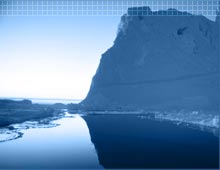 |

December 23, 2002
In one week I will board the research vessel R/V
Laurence M. Gould and set sail for Antarctica, a journey I
have anticipated for more than two years. It is penguins that
are taking me there. Ad�lie
penguins on the Antarctic Peninsula have declined by more
than 50% in the last two decades. Some ad�lie [pronounced like
the Indian capitol, Delhi, with an "ah" in front] colonies there
have completely disappeared. Ornithologist
Bill Fraser, who has studied this species there for a quarter
of a century thinks these birds are early casualties of global
warming. Winter temperatures on the Antarctic Peninsula have shot
up an astounding 10 degrees Fahrenheit in the last 20 years. It's
still cold there (Average temperatures vary from the mid 30s in
January to the high teens in August). But 10 degrees is a huge
change. If Fraser is right these penguins are among the first
evidence of what could be worldwide changes to plant and animal
communities caused by warming.
As a guest of the National
Science Foundation at the Palmer
research station, I'll be one of the only journalists to report
on Bill Fraser's exciting research in person. While I'm there
I'll also have the opportunity to report on some of the other
research that takes place at this tiny scientific outpost on the
rim of the world's most forbidding continent. Fraser is also studying
the impact of tourism on penguins (about 15,000 tourists in cruise
ships visit Antarctica each year, 1,500 of whom stop in at Palmer
Station). Donna
Patterson, Fraser's wife, is studying breeding and migration
of southern giant petrels. This huge bird (its wings stretch almost
seven feet tip-to-tip) is declining throughout Antarctica. However
at several islands along and near the Antarctic Peninsula it's
thriving. Patterson wants to know why. I'll also be learning about
research on the chemical warfare fought between predator and prey
in the Southern Ocean's icy waters. University
of Southern Florida chemist Bill Baker will be making dives
to sample sea life like sponges. Baker says his research will
not only clarify how species interact but could also yield discoveries
of compounds that could have applications as new drugs. I will
have the chance to watch the activities of scientists aboard the
Laurence Gould who will be taking a cruise along the
Antarctic Peninsula to increase understanding of the biology
of the Southern Ocean.
Getting ready for this six-week expedition
was a big job. The boat I'll arrive on will be the same one that
will take me back 31 days later. There will be no chance of getting
extra equipment or supplies in between, so I've had to make meticulous
preparations. I have backups for every piece of equipment I'm
bringing, including recording devices, cables, cameras, microphones
and batteries. Batteries are a special concern because most of
my equipment-my minidisk recorder, my microphones, my camera,
laptop computer and video camera-is battery operated. Batteries
don't work as well in the cold. The Antarctic Peninsula is not
only cold but wet. So I'll be carrying (lugging is more accurate)
my equipment in three sturdy waterproof cases.
As a science journalist I've had the good fortune to visit many
beautiful and exotic places including the Australian outback and
Alaska's far-north Seward Peninsula. I've been put up by Eskimos,
interviewed Australian aborigines and recorded an Argentine rain
forest. This trip will be the most exciting yet, challenging me
to stretch my skills as a reporter, audio engineer, photographer
and outdoorsman to the limits. I'll be flying to Punta Arenas
at the tip of South America, with a layover in Santiago, Chile-where
I'll interview environmentalists about the impact of long-line
fishing on fish and birds. In Punta Arenas I'll interview a doctor
who has studied the impact there of the ozone hole on sun burns
and skin cancer. Then I'll pick up survival gear and board my
ship. We'll sail though the Straits of Magellan, named for legendary
16th century explorer and round Cape Horn into Drake Passage,
an area Ernest
Shackelton biograher Alfred Lansing called as "the most dreaded
bit of ocean on the globe." In his book Endurance Lansing describes
the stormy seas there created by intense winds stirring up currents
circling round the white continent:
The waves thus produced have become legendary among seafaring
men. They are called Cape Horn Rollers or "graybeards." Their
length has been estimated from crest to crest to exceed a mile,
and the terrified reports of some mariners have placed their height
at 200 feet, though scientists doubt that they very often exceed
80 or 90 feet. How fast they travel is largely a matter of speculation,
but many sailormen have claimed their speed occasionally reaches
55 miles an hour. Thirty knots is probably a more accurate figure.
As I journey
to Antarctica and once I arrive there I'll be posting the sounds,
sights and my thoughts on this web site. I hope you'll join me.
|



